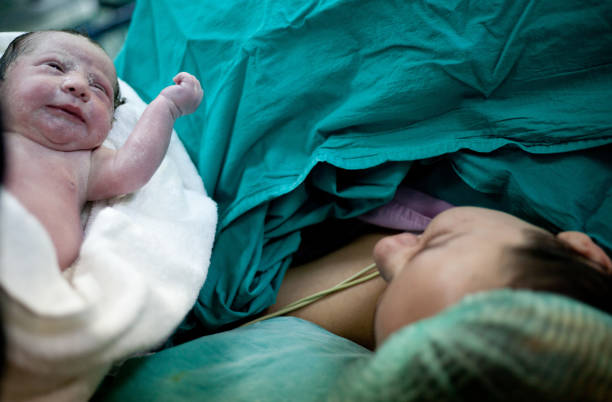A caesarean section is an important surgical intervention that can save the lives of mother and baby. Caesarean sections are essential in complicated labours such as prolonged or obstructed labour or if the baby is distressed.
The World Health Organization says that while “every effort should be made to provide a caesarean section to women in need”, country caesarean rates should range between 10% and 15%.
In South Africa rates are much higher in both public and private sector hospitals.
In public hospitals, caesareans accounted for 28.8% of all births between 2020 and 2022. In private sector hospitals the rate is 75%.
Globally the average is 21%. In Europe the rate is 25.7%.
As specialists in obstetrics and paediatrics we argue that South Africa’s caesarean section rates are too high. The over reliance on caesarean births places mothers and babies at great risk, including death and possible effects on brain development which have major implications for the child’s future.
There are a number of reasons for South Africa’s high rates. The main one is that caesarean section delivery is often perceived as the safer way to give birth. Other reasons include choosing a delivery date that is convenient for both the mother and doctor and fear of medical malpractice suits if the outcomes of vaginal delivery are not as expected.
Why caesarean section births are dangerous
Women who have caesareans in public hospitals in South Africa are three times more likely to die than those who undergo normal vaginal delivery.
Some of the immediate risks to the mother after caesarean sections include:
- prolonged abdominal pain and longer recovery time
- injury to the bladder or ureter
- heavy bleeding after birth with a need for a blood transfusion
- an unplanned hysterectomy
- blood clots, infection and death.
For future pregnancies, there is an increased risk of a repeat caesarean section, stillbirth and premature birth.
There is also the danger of placenta praevia. This is when the placenta blocks all or part of the baby’s exit from the vagina. Another risk is placenta accreta, which occurs when all or parts of the placenta remain attached, leading to increased bleeding in the mother and even death.
What’s lost
A natural birth involves three important steps: the spontaneous onset of labour, the process of labour itself, and vaginal passage.
1) The spontaneous onset of labour is important because it suggests the baby’s organs are mature. Delivery before this risks organ immaturity and serious health conditions.
The foetal brain develops fast in the last weeks of pregnancy. Earlier interruption of brain development leads to significant increases in special educational needs.
2) The process of labour: a unique surge of hormones is secreted. These hormones and the physical forces are essential for the physiological readiness of both the mother and her baby. It equips the mother to make the transition from a pregnant woman to an effective mother and for the baby to move from being placenta-dependent to surviving independently.
These hormones are also necessary for the woman to bond with her baby and to initiate successful breastfeeding, while they support the infant to self-regulate critical early body functions like temperature control, glucose metabolism and oxygen exchange.
A significant number of women who do not go through labour will not be able to breastfeed their babies exclusively.
3) We now know that the vaginal passage is more important than previously thought.
Babies are born with a microbiome, albeit sparse, as well as an immature immune system, and the two develop together. The first microbes to colonise a baby’s gut, airway, skin and mouth help teach the immune system what’s harmful and what’s not.
Vaginal birth marks an important step, exposing an infant to the array of mom’s vaginal and rectal bacteria as he or she passes through the birth canal. A baby delivered by caesarean section receives a totally different collection of microbes that persist for months, and even the first years, of life. This not only affects the immune system but also other important processes like brain and metabolic health.
The infant immune system must “learn” to tolerate non-harmful proteins coming from foods, domestic animals and our own body cells, but at the same time defend against protein signals from harmful microbes. Immune failure and lack of immune tolerance (allergy, asthma and autoimmunity) are clearly associated with caesarean births.
Reversing the trend
Caesarean section delivery is often perceived as the safer way to give birth. Expectant mothers often believe they prevent birth injuries such as cerebral palsy. However, research shows the prevalence of cerebral palsy does not decrease with increased caesarean section rates.
There must be a strong, unanimous message from the scientific community alerting role players and the public to the risks associated with unnecessary caesarean deliveries.![]()
Priya Soma-Pillay, Chair: School of Medicine and Head of Department: Obstetrics and Gynaecology, University of Pretoria and Andre Van Niekerk, Paediatrician, Paediatric Pulmonologist, Associate Professor, Department of Paediatrics & Extraordinary Professor, Department of Immunology, University of Pretoria
This article is republished from The Conversation under a Creative Commons license. Read the original article.











